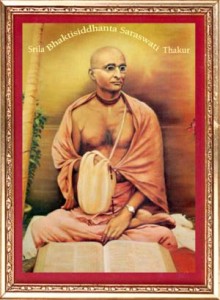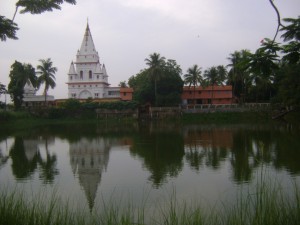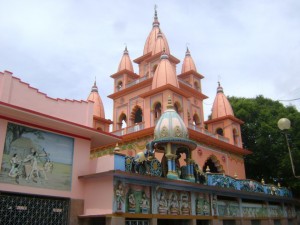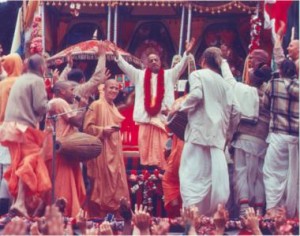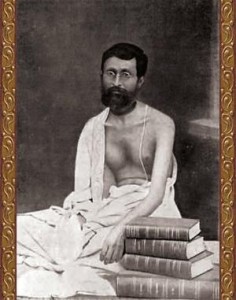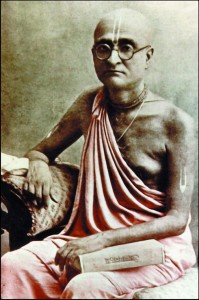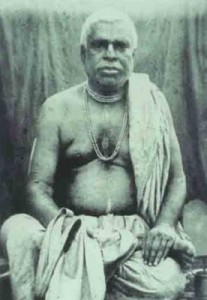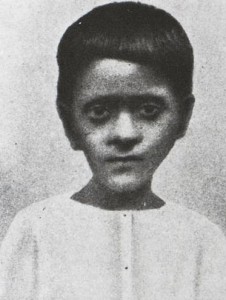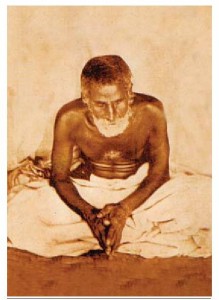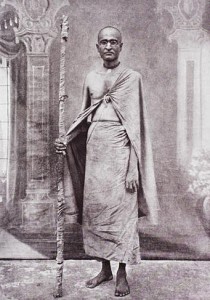Srila Bhaktisiddhanta Saraswati Prabhupada was known as 'simha' (lion) 'guru' due to his fearless and ferocious preaching. If an impersonalist saw him on the street, the impersonalist would cross the road in fear, or turn off onto another street. Those who didn't, Srila Bhaktisiddhanta would go up to and shake them violently, his huge body towering over them, and say, "Why do you say the Lord has no form? Nonsense offender!"
We have already mentioned his birth and some of his early pastimes in conection with his father Srila Bhaktivindoda Thakura, and his 'Guru' Srila Gaura Kishora dasa Babaji Maharaja.
He appeared on February 6th 1874. Father was deputy magistrate of Puri, had been for three years. Srila Bhaktivinode Thakur had been concerned that the pure teachings of Sri Chaitanya Mahaprabhu would be usurped by unauthorized persons, who were members of 13 apasampradayas and so he prayed for a Ray of Vishnu. Srila Bhaktivinode Thakura had started his mission for Lord Caitanya late in life. He was also very busy with his profession. But he wrote profusely, and wanted someone to preach boldly to establish these pure teachings.
The Padma Purana predicted Srila Bhaktisiddhanta Saraswati: a very elevated, pure and learned personality would appear in Purushottama-ksetra to spread the glories of Lord Jagannatha all over the world. His activities would be very unique.
When he was 6 months old, the Rathayatra was held. The cart stopped in front of Srila Bhaktivinoda's house (which was on the main road between the temple and the Gundica mandira. The cart stayed there for 3 days. On the 3rd day, Bhagavati devi (mother of Srila Bhaktisiddhanta Saraswati) brought out the child and the 'pujaris' picked him up and put him on the cart. He crawled to the base of Lord Jagannatha, and touched His lotus feet. Simultaneously a garland fell from the neck of the Lord and landed around the child. The pujaris exclaimed that this boy is particularly blessed by Lord Jagganatha.
The 'Annaprasha' festival (first grains ceremony), first grain taken by children which is usually given when the first sign of teeth are there something like six-months old, so for Srila Bhaktisiddhanta Saraswati the first grain was Jagannatha Prasada. Vimala devi is offered the 'prasada' after Jagannatha takes; hence his name Bimala Prasada. When during the 'Anna-prasna' ceremony the child is shown the 'shastra' and coins to give some indication as to his nature by what he goes for baby Bimal chose the Srimad Bhagavatam as opposed to the gold coins.
When he was five family had become senior deputy magistrate: only three of these in all of India under British Raja. Mango incident happened at this time. Never again took ripe mangos. But he took green mango chutney offered by his disciples; this was a favourite of his.
When Srila Bhaktisiddhanta Saraswati was 7 years old, his father Srila Bhaktivinoda Thakura moved to Calcutta, to the "Bhakti-Bhavan" house was building. While digging foundation they found Deity of Lord Kurma. Srila Bhaktivinoda Thakura gave him his first initiation and the name Siddhanta Saraswati; and initiated his son into the worship of Lord Kurma. He was doing this every single day without missing. Even when he was admitted into school.
He was a very expert student. However his preference was to study the Vaishnava books of his father. He did just that and studied books of Srila Bhaktivinoda Thakura, but never fell behind in school – he remembered everything after hearing it once. His teachers were astonished, and his father was very pleased.
As a boy, Bimala Prasada delivered his oldest brother Acyutananda from an offense he'd made in his last life. Acyutananda had a nervous disease, and once became very sick. Bimala Prasada took 'karatals' and chanted the 'Hare Krishna mantra' constantly for 6 days without eating. Then Ramanuja-sampradaya 'tilaka' appeared on Acyutananda's forehead. He said, "I am a Ramanuja Vaishnava. I committed an offense to a Gaudiya Vaishnava in my last life and therefore had to take this birth. Now I am relieved." Then he left his body for dead.
In 1892, after passing his entrance examination, Bimala was admitted into the Sanskrit College of Calcutta. There he spent considerable time in the library studying various books on philosophy. He also studied the Vedas under the guidance of Prithvidhara Sharma. As a student he contributed many thoughtful articles to various religious journals. However he did not continue with his college studies for long.
We told this story before, but from another angle; Srila Bhaktivinoda Thakura had taken initiation from Bipin Bihari Goswami, who came in the line of Gadadhara Pandit, through Janavi Devi. However once when Bipin Bihari Goswami was visiting Srila Bhaktivinoda Thakura, the Thakura paid obeisances and Bipin Bihari Goswami placed his foot on Srila Bhaktivinoda Thakura's head. Srila Bhaktisiddhanta Saraswati saw this and was surprised. He thought this was a dangerous thing for Bipin Bihari Goswami to do. When Srila Bhaktivinoda Thakura left the room, Srila Bhaktisiddhanta Saraswati Thakura asked him a question: "You are my father's 'guru'. But do you know who he is?" Bipin Bihari Goswami was taken aback at this 7-year-old's question. Srila Bhaktisiddhanta Saraswati continued, "My father is a 'nityasiddha', an eternal associate of the Supreme Lord. Do you have sufficient spiritual potency to place your foot on his head?" Srila Bhaktivinoda Thakura returned at this time, so the conversation was interrupted. Bipin Bihari Goswami said, "Your son is bold to the point of being rude." Later on, Srila Bhaktivinoda Thakura found this out and used to tell this story to his disciples.
Srila Bhaktivinoda Thakura in krishna-lila is Kamalaman-manjari, and Srila Bhaktisiddhanta Saraswati is his eternal assistant, Nayana-manjari. At age 13 he started higher education. Once Srila Bhaktivinoda Thakura returned from Puri with Tulasi and initiated his son into chanting Hare krishna Mahamantra and he also took 'Nrsingha mantra' initiation, 'ugram bhiram maha-vishnum'etc.
During this time he invented, and developed a shorthand script called 'Vikanta', so much was his genius.
Srila Bhaktivinoda Thakura, after seeing the wonderful vision of a golden 'mandira', began begging door to door for funds to establish the Yoga Pitha. At 18, Srila (Bhakti) Siddhanta Saraswati entered Capital Sanskrit College affiliated with Calcutta University. Within a short time mastered the 6 limbs of Sanskrit studies: 'shiksha', 'jyotish', 'chanda', 'alankara', etc.
When Srila Bhaktisiddhanta Saraswati was 22 he left college to avoid taking householder life. He took up work under the king of Tripura. Tripura had been turned to a Vaishnava state by the king of Manipur, who was a disciple of Narottama dasa Thakur.
So Srila Bhaktisiddhant Saraswati became Raja Pandit there for 3 years. He retired with full pension, which Srila Bhaktisiddhanta Saraswati accepted for a few years and then voluntarily stopped.
Around this time he took initiation from Gaura Kishora dasa Babaji. Srila Gaura Kishora dasa Babaji had been a grain merchant before taking 'babaji'. He'd gone to Vrindavana and did 'bhajana' for a long time. Then he came to Navadwipa. By this time Srila Bhaktivinoda Thakura had retired and had built a 'bhajana kutir' in Navadwipa (Godruma). He gave Srimad Bhagavatam class there every day. Srila Gaura Kishora dasa Babaji used to come to these classes. Srila Bhaktivinoda told Srila Bhaktisiddhanta Saraswati to accept Srila Gaura Kishora as initiating 'guru'. Srila Bhaktisiddhanta Saraswati approached Gaura Kishora, asking "Please give me your mercy." Gaura Kishora answered, "Mercy is not mine to give. It is the property of Lord Chaitanya Himself. I'll ask Him, and if He agrees, I can give you."
Second time they met, Srila Bhaktisiddhanta Saraswati inquired, "Did you ask Him?" "No, I forgot." Third time same thing happened. Srila Bhaktisiddhanta Saraswati said, "You worship that great cheat, Krishna, Who is cheating everyone. And so you are also cheating me. But if you continue in this way, I will simply give up my life, because my life is useless without receiving you mercy." Then Gaura Kishora das Babaji gave initiation to Srila Bhaktisiddhanta Saraswati as Varshabhanavi-devi dasa. Then Srila Bhaktisiddhanta Saraswati gave up all other activities to chant 194 rounds daily for 7 years. He had a 'kutir' but did not spend the time to repair the roof; he just used an umbrella if it rained.
In 1897 he started an autonomous Catuspathi ('Sanskrit' school) wherefrom monthly journals entitled "Jyotirvid", "Vrihaspati", and many old treatises on astrology were published. In 1898, while teaching at Sarasvata Catuspathi, he studied Siddhanta Kaumudi under Prthvidhara Sarma, at Bhaktibhavana. By the time he was twenty five he had become well versed in Sanskrit, mathematics, and astronomy, and he had established himself as the author and publisher of many magazine articles and one book, Suryasiddhanta, for which he received the epithet Siddhanta Sarasvati in recognition of his erudition.
In 1895 Sarasvati Goswami accepted service under the Tripura Royal Government as an editor for the biography entitled Rajaratnakara, the life histories of the royal line of the independent Tripura Kingdom. Later he was entrusted with the responsibility of educating the Yuvaraja Bahadur and Rajkumar Vrajendra Kisore, in Bengali and Sanskrit. After a short period of time, Siddhanta Saraswati took up the responsibilities for inspecting various ongoing activities in the royal palace for the state of Tripura. However, after finding enviousness, malice and corruption surfacing in every corner of his inspection, Siddhanta Saraswati very quickly developed an aversion to state affairs and gave notice of his intention to retire to Maharaja Radhakisore Manikya Bahadur. The Maharaja approved of Siddhanta Sarasvati's plans for renunciation and awarded him full pay pension. However, after three years Siddhanta Sarasvati also renounced his pension. With his father, he visited many Tirthas and heard discourses from the learned pandits. In October 1898 Siddhanta Sarasvati accompanied Bhaktivinoda on a pilgrimage of Kasi, Prayag, Gaya and other holy places. At Kasi a discussion was held with Ramamisra Shastri regarding the Ramanuja Sampradaya. After this talk Siddhanta Sarasvati's life seemed to take a turn, his inclination towards renunciation increased, and he quietly continued to search for a 'sadguru'.
When Siddhanta Sarasvati was twenty six his father, understanding the mind of his son, guided him to take initiation from a renounced Vaisnava saint, Gaura Kishora dasa Babaji, who we will now bring into the picture. actually it is inpossible to separate these three especially, anyway we will do our best to shed some light on their all effulent forms. Although it is like shining a candle to illumine the Sun globe.
One discipline of Srila Bhaktivinoda Thakura who wanted to continue the mission came looking for Srila Bhaktisiddhanta Saraswati in Navadwipa at this time, knowing him to be as powerful a personality as his father. He went around asking the locals if they knew of a sadhu matching Srila Bhaktisiddhanta Saraswati's desciption, but they all answered, "We don't know of a sadhu, we only know of one madman. We see him moving here and there, crying aloud and sometimes rolling on the ground." So he went searching for him in the jungle next to the Ganga, where they said he sometimes could be seen. Suddenly he heard Srila Bhaktisiddhanta Saraswati crying "Krishna Krishna Haribol! Nitai Gaura Hari Bol!" He saw him burst out from the forest and plunge, fully dressed, into the Ganga. He kept on shouting in the water, splashing about. Then he came out. The disciple of Srila Bhaktivinoda Thakura then approached him, requesting him to come to Calcutta to head up the sankirtana mission there. Srila Bhaktisiddhanta Saraswati answered, "Sankirtana? Can you not see the wonderful 'sankirtana' mission of Sri Caitanya right here in the holy 'dham' of Navadwipa? Is it not wonderful? Sri Pancha-tattwa are chanting and dancing in ecstacy, surrounded by all their associates. Can you not see this?" Then Srila Bhaktisiddhanta Saraswati ran off, again shouting "Haribol" in great ecstacy. As it was sunset by this time, that man took his bath in the Ganga, and mentally renounced the idea of organizing the 'sankirtana' mission.
But later on, in 1918, Srila Bhaktisiddhanta Saraswati appeared at his door in Calcutta, in 'sannyasi' robes with 'danda', freshly shaven, and ordered, "Now we are founding a Society, the Sri Gaudiya Matha. Draw up the papers immediately and have it registered. Though he'd arrived at 4 p.m., the work was done before that same afternoon was ended.
Even before 1918 he decried the 'Jatigosai'/'brahmana' monopoly of giving initiation only to born 'brahmins'. He preached very boldly against them. The 'brahmins' challenged him, "where does the 'Gaura mantra' appear in any authorized scripture as a Gayatri?" (Because the Gaudiya Vaishnavas would take this 'mantra' as a 'pancharatriki mantra' for 'brahminical' initiation.) They said, "Sri Chaitanya claimed only to be a devotee. Why do you say he is the Supreme Personality Of Godhead and use His name in place of authorized scriptural names and 'mantras'?"
Srila Bhaktisiddhanta Saraswati cited Chaitanyopanishad from the Atharva-veda, discoverd by Srila Bhaktivinode, 19 verses glorifying Lord Chaitanya. In another assembly he directly attacked the 'brahmins' and 'Jati Gosais'. He initiated the movement to take back the teachings of Lord Caitanya from the hands of such unauthorized persons. Srila Vishvanatha, Srila Baladeva Vidyabhusana, his disciple Uddhava dasa Babaji, his disciple Madhusudana dasa Babaji, were all saintly renounced souls: after Baladeva there was no-one to strongly represent the pure teaching of Lord Caitanya and preach them boldly. During Srila Bhaktivinoda Thakura's time, Gaudiya Vaishnava meant Baul, Aula, Sakhi-Beki, Jati Gosai, etc. who were all degraded. The Vaishnavas got no respect. At this time the shaktas became strong from Rama-Krishna-Vivekananda, and this put further obstructions for the establishment of pure Vaishnava dharma. Srila Bhaktisiddhanta Saraswati preached against all of this nonsense.
When Srila Gaura Kishora dasa Babaji Maharaj left the planet, the 'babajis' wanted to do the 'samadhi' rites. He'd said he wanted to have his body dragged through the streets by his "disciples". The 'babajis' had gathered to do that, they'd tied a rope around the neck.
Srila Bhaktisiddhanta Saraswati crossed over to Navadwipa from Mayapura and stopped them, saying "None of you are his disciples." Babaji Maharaja had one disciple, that one was Srila Bhaktisiddhanta Saraswati, (in other records it says he only had two disciples, the other was Vamsivata dasa Babaji Maharaja, who was an 'avadhuta'). "I am the right claimant to perform these last rites." They said, "But he was a 'babaji', and you are not." Srila Bhaktisiddhanta Saraswati answered, "Gaura Kishora dasa Babaji does not come in 'babaji' line. He was initiated by Nimai Chand Goswami, who was a Nityananda Parivat, coming in the line of Lord Nityananda. He received his 'Vesha' ('babaji' dress) from Bhagavata dasa Babaji Maharaja, who is an initiated disciple of Jagannatha dasa Babaji."
Before Srila Bhaktisiddhanta Saraswati, from time of Lord Caitanya Mahaprabhu, param-bhakta Vaishnavas would get 'Vesha' (white knee length cloth, 'koupin', waterpot and bead-bag) initiation, not 'tridandi sannyasa'. "Bhaktivinode Thakur also took 'Vesha' from Jagannatha dasa Babaji. Srila Bhaktivinoda Thakura, though 'diksha' initiated of Bipin Bihari Goswami, received 'siksha' and 'vesha' from Jagannatha dasa Babaji. And Gaura Kishora dasa Babaji received 'siksha' from Srila Bhaktivinoda Thakura. Sri Caitanya Mahaprabhu's line is Bhagavata Parampara, not seminal line." So he challenged them to show that any such line came from Rupa or Sanatana Goswami. As to be a Rupanuga means coming in Bhagavata Sampradaya. Rupa told of Advaita's rejecting His own son Madhusudana because he accepted Lord Caitanya only, but not Lord Nityanananda.
"If you are Babajis, then you are fully sense controlled. So the one of you who has not engaged in any illicit activities in the past 1 year, come and do the last rites." No one stood up. "One month? One week? 24 hours?" No one stood up. Srila Bhaktisiddhanta Saraswati then placed Gaura Kishora dasa Babaji Magharaj's body in 'samadhi'. So after finishing with the 'smartas', 'jati gosais', he took on 'Babas'. He would take on and defeat anyone solely to establish pure unalloyed, undeviated krishna consciousness.
Then in 1918 he opened his first center in Ultadanga Road in Calcutta. He was then 44. Kunjabihari Vidyabhusana (Bhakti Vilasa Tirtha Maharaja) was his main manager and a prominent devotee in the Matha. Srila Bhaktisiddhanta Saraswati had made a vow after taking 'sannyasa' that he would never touch money. Everything was arranged by his disciples. Many of them wishing to assist his mission took up responsible jobs, e.g. Kunja Babu became a post-master.
Srila Bhaktisiddhanta Saraswati did 'nagara kirtana' with disciples and was invited to programs by the King of Burdwan or the King of Kooch Bihar; everywhere he established Lord Caitanya's teachings as the most excellent spiritual philosophy.
He knew all Vaishnava philosophies most expertly. He brought out books on their 'darshans', e.g. Madhvacharya's arguments against Mayavadis.
As well as other Vaishnavacaryas like Ramanuja. In the temple he established in Mayapur he built 4 small temples in honor of the 4 Vaishnava sampradayas. He put the deities of the 4 founder acaryas there; Madhwacarya; Ramanujacarya; Nimbarkacarya; and Visnu Swami.
He started the Gaudiya Mission in the midst of war and national liberation agitation. He was uncompromising in his disregard of such mundane concerns. "The most important thing is to invoke the spirit of devotion to the Supreme Lord; this concern lies far above any material consideration." Many leaders objected, but he continued. In this period the aristocratic young Abhay Charan De (latter known as Srila A.C.Bhaktivedanta Swami Prabhupada) visited Srila Bhaktisiddhanta Saraswati on the rooftop at Ultadanga Road; At this time Abhay charan De was adherent of the national liberation movement, but Srila Bhaktisiddhanta Saraswati convinced him in one sitting of the vital necessity of Lord Caitanya's mission over everything else.
Srila Bhaktisiddhanta Saraswati's 'sannyasa': happened in 1918. He could have taken 'babaji' but didn't. Many 'babajis' wanted to initiate him, as he'd shown himself to be such a powerful exponent of Vaishnavism (e.g. his 3-day debate with caste 'brahmins' attended by Vaishnava scholars, in which he resoundingly defeated caste pretensions and established the Vaishnava view of 'brahminical' status by quality of work, not birth).
When he gave himself 'tridandi sannyasa' (or more correctly, had taken 'sannyasa' from a picture of Gaura Kishora dasa Babaji Maharaj), this was a shock to even his supporters, including disciples of Srila Bhaktivinoda Thakura. The controversy was not over the method of initiation in this instant as some criticise him for. But over 'varnashrama'; they thought he was returning to the 'Varnashram-dharma' that Lord Caitanya had rejected in his talks with Srila Ramananda Raya. But the concern was for nothing, as he was not continuing the bodily 'varna'-and-'ashram' system, but was establishing 'Daivi-varnashrama'.
Srila Prabhodananda, Lokanatha Goswami were great Gaudiya 'sannyassis' of the past. Prabhodananda Saraswati converted a great 'smriti acharya', Gopal Bhatta Ghosh, and gave him 'tridandi sannyasa'. Srila Gadadhara Pandita was also 'tridandi sannyasi'. Without establishment of 'Daivi-Varnashram-Dharma', 'babaji' (supposedly, or with the concept of 'paramhamsa' initiation) will, as it had become a farce.
In this way Srila Bhaktisiddhanta Saraswati travelled and preached initially from Mayapura to vrindavana and challenged the authority of the 'babajis', and others.Some ritualistic and narrow minded persons found fault, as one can even do with the moon in the sky. "They protested that this was unauthorized." He said, "Everything I am doing can be supported by scriptural reference, but nothing you do can be. You take young boys who don't even know how to clean themselves after passing stool and giving them 'sakhi rupa.' I am giving 'samskara' to reform the fallen souls, and this 'samskar' is the 'Hari Nama', which Lord Chaitanya gave as the 'siddha pranali'. No rules of caste or creed bind this 'Harer Nama diksha."
Then they tried to say that Srila Bhaktisiddhanta Saraswati was not properly initiated in an established line. He disproved this. Srila Gaura Kishora dasa Babaji Maharaja was initiated in line of Nityananda, but he (Srila Bhaktisiddhanta Saraswati) did not accept that line. In fact Srila Bhaktisiddhanta Saraswati rejected that line from Nimai Jatgoswami (line of Nityananda, Jahnavi, Bir Chandra Prabhu. Rather Srila Bhaktisiddhanta Saraswati Thakura stressed Bhagavata Sampradaya, and didn't care for material or seminal lines.
Therefore in his pranams the term, 'Rupanuga virrudhapa siddhanta', 'any conclusion against the precepts of Rupa Goswami is to be rejected immediately' is to be found.
In his life he founded 64 Gaudiya Math temples throughout India. For his further preaching and attempts to spread krishna consciousness beyond the bounds of India, as his father had desired too, he sent three disciples to west, and he gave ten westerners initiation, mostly from young intelligent men from Germany and a couple of elderly women in St John's Wood in London, by sending sannyasis to Germany and England(Rupa Vilasa dasa. 1988. "Raya of Visnu".).
During this time Abhay Caran De (Srila A.C. Bhaktivedanta Swami Prabhupada) met Srila Bhaktisiddhanta Saraswati Prabhupada. He was a young man – a 'khadi' clad follower of Gandhi's national movement. Srila Bhaktisiddhanta Saraswati Prabhupada, seeing this bright faced young man before him, convinced him of a necessity to preach krishna consciousness. "In this world there is no shortage of anything, only krishna consciousness." Srila Bhaktisiddhanta also requested young Abhay Caran De, "You are an intelligent young man. If you ever get money, print books in the English language." Our Srila Prabhupada was so impressed that he took this as his life's mission. Some eleven years later he took diksa initiation from Srila Bhaktisiddhanta Saraswati Thakura, who told his other disciples who printed the Sajjana Tosani newspaper on his order, "Whatever Abhay Caran writes, print it." He obviously knew his worth.
Srila Bhaktisiddhanta Saraswati Prabhupada was always eager to reveal transcendental knowledge. Whenever he found an eager listener he would go on speaking, not knowing bounds of time and space. Disregarding requests of his medical advisers, up to the last moment, he continued to deliver the message of the Supreme Lord to all people. This was his only purpose for his appearance in this world. All his tours were highly successful, though not without events because many of his disciples were not from orthodox 'Brahmin' families. Though they wore the sacred 'yajnopavitra', 'brahmin' thread of the twice-born, many so-called 'Brahmins' objected. Shops would refuse to sell their goods to Bhaktisiddhanta's 'brahmana' and 'sannyasi' disciples, even though according to the 'Pancaratrika' system of 'Vaisnava agamas', they were all properly initiated as 'brahmanas' and 'sannyasis'.
His whole life was spent in a mood of loving devotion to the Lord. He was fully devoted to spreading the teachings of Sri Caitanya Mahaprabhu. The numerous publications and commentaries on the works of the previous 'acaryas' establishing the Lord to be 'saccidananda vigraha' is quite evident of this fact.
In 1936, whilst residing in the holy dhama of Jagannatha Puri at the age of 62, he left this mortal world to again return to the loving pastimes of Sri Sri Radha krishna in Brajaloka the topmost planet in the spiritual sky.
Srila Bhaktisiddhanta Saraswati used to "install" the printing presses that were acquired by the Gaudiya Matha for literature publication.
He gave many a heavy class on detachment from material life. Later, while writing, he observed a monkey stealing bananas from the godown, which was just next to his study. He ran out with a stick to chase the monkey away, overturning his writing table and spilling ink on the pages of his manuscript. When the cook saw this, he inquired, "Today you told that one must be detached. How to understand your behaviour just now – for two bananas you jumped from your writing to chase a monkey, and even ruined your work in the process?" Srila Bhaktisiddhanta Saraswati answered, "These bananas belong to Srimati Radharani, because they are to be used in Krishna's service."
He went to take a bath in a 'pukkur', and when he was seven steps above the surface of the water, the water rose seven steps and touched his lotus feet. Then all the 'brahmacaries' jumped in, to bath in the 'caranamrta'.
At the Yoga Pith temple was a cook who was very passionate. He fought with every devotee there except for Srila Bhaktisiddhanta himself. Then he died. After the funeral ceremony was completed, the Gaudiya Matha 'brahmacharies' were sitting together and talking about how much trouble they'd had with the cook – each was telling stories about the fights he'd had with him. Suddenly Srila Bhaktisiddhanta Saraswati appeared at the doorway and said, "He always washed his 'dhoti' nicely and was very clean." From then on nobody dared say anything negative about that cook. Although Srila Bhaktisiddhanta was renoun for his aggressive, and even 'chopping' attacks on the 'mayavadins' and other such offenders, he always showed true Vaishnava respect and appreciation for all of the devotees.
When one 'mayavadi sadhu' was preaching his oneness philosophy in the presence of Srila Bhaktisiddhanta Saraswati and his disciples while they were riding on a train from Calcutta to Puri, Srila Bhaktisiddhanta ordered his 'brahmacaries' to feed the 'sadhu' some rotten mangos which had been donated to his party earlier (they were ripe when donated, but got rotten because Srila Bhaktisiddhanta would not take them due to his vow, and therefore no disciple would take either). After being obliged to eat four mangos, that sadhu fell at Srila Bhaktisiddhanta's feet and swore he'd never preach the philosophy of exclusive undifferentiated oneness again.
His 'kirtana' procession (with him personally at the head) would stop all traffic wherever it went in Calcutta; in Puri even the brahmins accepted his 'nam-sankirtana' as fully authorized.
He stayed in Puri in his last days. He lectured for some days at the place known as "Goverdhana" in Puri, and before and after his talk he would recite prayers praising Goverdhana Hill and requesting shelter in some corner there. He would sometimes comment to his disciples, there's not much time left. They could see something was going to happen soon, but weren't sure what.
He got very sick ten days before he left his body. Two days later he wrote his last instruction: "Somehow we must become qualified to attain the shelter of Rupa and Raghunatha. Always chant Hare Krishna, always preach Krishna consciousness, and stay away from Vaishnava-aparadha. In this way become qualified to get the shelter of the lotus feet of Sri Rupa and Raghunatha." Two days after that he wrote his letter to Srila Prabhupada (Abhaya Charan De).
All the big intellectuals of Calcutta had a memorial gathering upon hearning word of his death. One (an atheist), in eulogy, said: "Who will we argue with now?"
The full life story of His Divine Grace Srila Bhaktisiddhanta Saraswati Goswami Maharaja Prabhupada can be found in one very nice book which is a compilation and summary study of many books of the time on the life of Srila Bhaktisiddhanta, and is entitled "A Ray of Visnu," as was prayed for by his father before his taking birth. This book is available through ISKCON, and was published by Rupa Vilasa prabhu, a disciple of Srila A.C. Bhaktivedanta Swami Prabhupada.
Srila Bhaktisiddhanta Saraswati's father, Srila Bhaktivinoda Thakura, had a vision one night on the other side of the River Jalanghi, opposite his house. In the open fields he saw a huge city made up of all Vaisnavas from all over the world. There would be Americans, Australians, Canadians, Africans, Chinese, Russian, English, every nation's devotees dancing together in transcendental kirtan and chanting "Jaya saci-nandana gaura hari." Astrologers predicted that a person of great saintly character, full in all Vaisnava qualities, who could build a house in which the whole world could live peacefully, would appear to set back the flow of Kali Yuga.
We have seen after the passing of Srila Bhaktisiddhanta Saraswati Thakura Prabhupada, the Gaudiya Math underwent some difficulties. Although Srila Bhaktisiddhanta Saraswati Thakura had requested his disciples to come together as a 'Governing Body' to push on the mission after his demise, a couple of prominant disciple instead took the helm against his wishes which changed some of the intrinsic foundation of the Gaudiya Matha at that time. In relation to 'siksha' (instuctions) having precedence over 'diksha' (initiation) as a means of proper succession there came a splintering of the Gaudiya Matha because of neglecting the 'gurus' instructions. Since this time major valuation set-backs have been observed (A.C.Bhaktivedanta Swami Prabhupada. Sri Caitanya Caritamrta Adi Lila Chapter 12 text 8., The Asara son's of Advaita Acarya!)
Following the instructions therefore provides a strength in continuity of the overall success and chastity of the followers in the line's mission or purpose. On examination we find some intrinsic differences in the rhythm, movement and systems tha eventuated after this point in time despite 'all being disciples'. In many instances the disputes have to date remained unresolved. 'The Gaudiya Matha and Its Missions', today has many lines and sub-lbranches coming from the disciples of Srila Bhaktisiddhanta Saraswati Thakura Prabhupada.
At this time (the end of the 1930's) the saintly figure emerged, who was to become notably one of the great 'acaryas' in Vaisnava history, although he remained in humble circumstances, preparing himself for the mission that would not only fulfil his spiritual master, Srila Bhaktisiddhanta Saraswati Thakura Prabhupada's order, but would fulfil the desire of all the great Vaisnavas in the Brahma-Madhwa-Gaudiya Sampradaya and gain the praise and amazement of other 'sampradayas', religionists and scholars alike. That person is Srila A.C. Bhaktivedanta Swami, known by his loving followers as Srila Prabhupada.
We are presently awaiting a wonderful book by H.H. Bhaktivikash Maharaj which he has researched for the last ten years by speaking to the last of Srila Bhaktisiddhanta Saraswatis' disciples who are remaining in their old age on the planet, on the life of Srila Bhaktisiddhanta Sarasvati Thakur Prabhupada.
